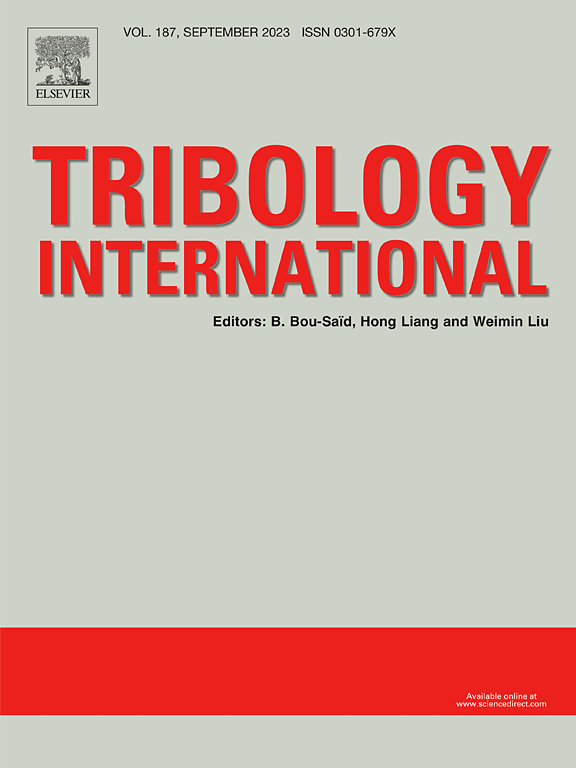摩擦驱动Ag/GO纳米复合材料和zn偏析诱导MgO/ZnO层的超低磨损ZK60镁合金
IF 6.1
1区 工程技术
Q1 ENGINEERING, MECHANICAL
引用次数: 0
摘要
ZK60合金固有的耐磨性较差,严重限制了其在剧烈摩擦条件下的应用。为了改善这一点,采用自顶向下的策略,结合自沉积和磁控溅射构建复合润滑涂层(Ag/GO-ZK60)。在15 N负载30 min下,Ag/GO-ZK60实现了0.048 μm3 N−1 μm−1的超低磨损率,与裸ZK60相比,磨损率降低了94.4 %。微观结构分析表明,这种改善源于摩擦驱动形成稳定的Ag/GO纳米复合材料,有效地防止了氧化石墨烯纳米片的分层。基于氧化石墨烯提供的连续润滑,进一步的摩擦驱动过程促进了Mg和Zn的迁移和选择性氧化,导致Ag/GO层下原位形成层状致密的MgO/ZnO异质结构。值得注意的是,氧化锌通过元素偏析富集并位于MgO下方,缓解了MgO与ZK60衬底之间的性能不匹配,从而增强了氧化层的界面稳定性,进一步提高了抗磨损能力。本文章由计算机程序翻译,如有差异,请以英文原文为准。
Ultralow Wear ZK60 Magnesium Alloy Enabled by Friction-Driven Ag/GO Nanocomposite and Zn-Segregation Induced Stratified MgO/ZnO heterolayer
ZK60 alloy inherently suffers from poor wear resistance, severely limiting its application under severe friction conditions. To improve this, a top-down strategy was employed, combining self-deposition and magnetron sputtering to construct a composite lubricating coating (Ag/GO-ZK60). Under a 15 N load for 30 min, the Ag/GO-ZK60 achieved an ultralow wear rate of 0.048 μm3 N−1 μm−1, corresponding to a reduction in wear of up to 94.4 % compared to that of bare ZK60. Microstructural analysis revealed that this improvement originates from the friction-driven formation of a stable Ag/GO nanocomposite, effectively preventing GO nanosheet delamination. Based on the continuous lubrication provided by GO, further friction-driven processes promoted the migration and selective oxidation of Mg and Zn, leading to the in-situ formation of a stratified and dense MgO/ZnO heterostructure beneath the Ag/GO layer. Notably, ZnO, enriched via elemental segregation and located beneath MgO, alleviates the performance mismatch between MgO and the ZK60 substrate, thereby enhancing the interfacial stability of the oxide layer and further improving the anti-wear capability.
求助全文
通过发布文献求助,成功后即可免费获取论文全文。
去求助
来源期刊

Tribology International
工程技术-工程:机械
CiteScore
10.10
自引率
16.10%
发文量
627
审稿时长
35 days
期刊介绍:
Tribology is the science of rubbing surfaces and contributes to every facet of our everyday life, from live cell friction to engine lubrication and seismology. As such tribology is truly multidisciplinary and this extraordinary breadth of scientific interest is reflected in the scope of Tribology International.
Tribology International seeks to publish original research papers of the highest scientific quality to provide an archival resource for scientists from all backgrounds. Written contributions are invited reporting experimental and modelling studies both in established areas of tribology and emerging fields. Scientific topics include the physics or chemistry of tribo-surfaces, bio-tribology, surface engineering and materials, contact mechanics, nano-tribology, lubricants and hydrodynamic lubrication.
 求助内容:
求助内容: 应助结果提醒方式:
应助结果提醒方式:


